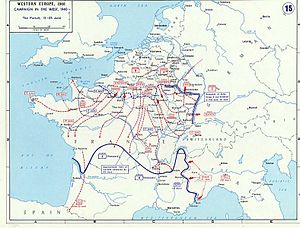Battle of Saumur (1940)
| Battle of Saumur | |||||||
|---|---|---|---|---|---|---|---|
 Fall Rot, June 1940 |
|||||||
|
|||||||
| Belligerents | |||||||
|
|
|
||||||
| Commanders and leaders | |||||||
|
|
|
||||||
| Strength | |||||||
| 560 Students of the Cavalry School 1,600 other elements |
c. 10,000 First Cavalry Division |
||||||
| Casualties and losses | |||||||
| 250 killed or wounded | 132 killed, and about 300 wounded | ||||||
The Battle of Saumur occurred during the last stages of the Battle of France during World War II, when officer cadets from the Cavalry School at Saumur, led by superintendent Colonel Michon, made a defensive stand along the Loire River at Saumur and Gennes. For two days the Cavalry School, and other assorted units which had fallen back before the German Wehrmacht advance, held off a German attack. Since the battle occurred after the message by Marshal Pétain which called for an end to fighting (on 17 June 1940), the event is often considered one of the first acts of the French Resistance.
In the first week of June 1940, in accordance with instructions by General Maxime Weygand to delay German Wehrmacht army units, Colonel Michon issued contingency orders for the cadets to take up defensive positions along the southern bank of the Loire, not that there was any likelihood of Germans getting to the Loire.
On 8/9 June there was an air raid against Saumur railway station, which killed three people. A further air raid at nearby Souzay took place on 13 June.
On 13 June Paris was declared an open city and a meeting of the Anglo-French Supreme War Council with Churchill and the French Prime Minister Paul Reynaud was taking place in Tours, on the Loire. On 14 June the French government left Tours and fled to Bordeaux, Wehrmacht troops entered Paris. On 15 June Reynaud resigned and Philippe Pétain became Prime Minister. Next morning, through the Spanish ambassador, Pétain asked Germany for a cease fire and announced this fact over the radio.
The Wehrmacht troops advancing south across France into the area of Saumur were from the 1st Cavalry Division (Germany). The battle therefore set graduates of the German cavalry school against the cadets from the French cavalry school. They had advanced at 45–60 miles a day. The Germans had 10,000 troops, some motorised, armoured cars, artillery and the usual divisional equipment, whereas the French troops comprised 800 of the younger cadets who had joined the school 3 months earlier, older cadets having been assigned as junior officers of regiments, those teachers who had not already joined their normal units, and any retreating men that could be collected to add to the defence.
...
Wikipedia
